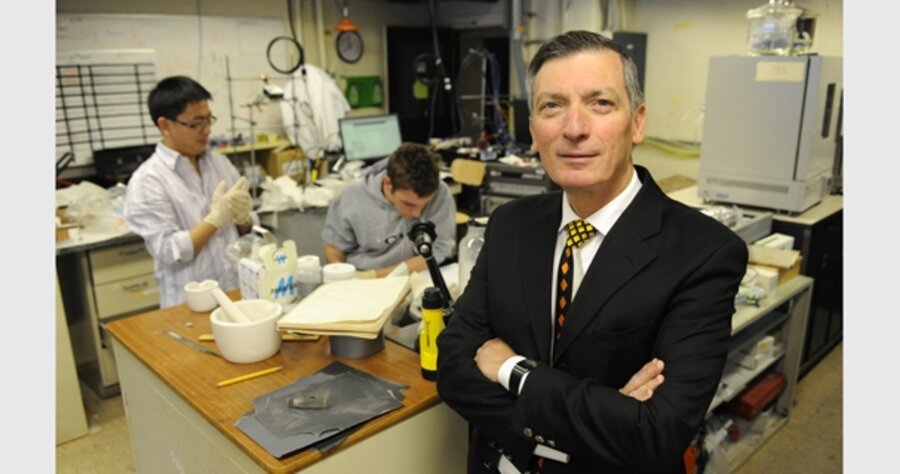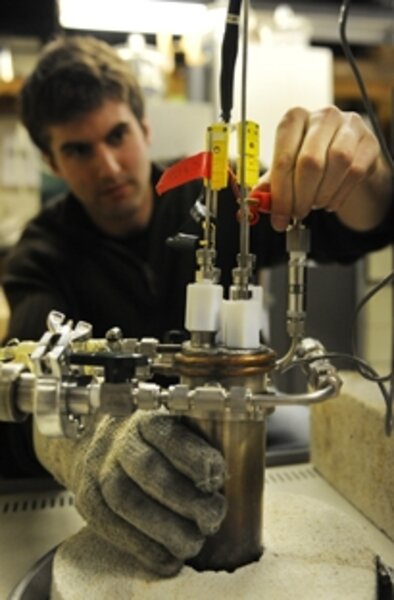Worldwide race to make better batteries
Loading...
| Cambridge, Mass.
Down in his basement laboratory at the Massachusetts Institute of Technology, Donald Sadoway and his students are hunting for the perfect battery. Not for cellphones or laptop computers, but to power a future generation of automobiles or perhaps the electric grid.
To achieve that goal, we will need batteries many times cheaper, safer, more powerful, and more durable than today’s best, professor Sadoway says. They must store enough juice to send a car 250 miles on a charge – and cheap enough to store solar or wind power for use at night and in calm periods, he says.
Risky, over-the-horizon research is vital because, although most Americans and politicians don’t know it yet, the United States is in a global race to build a new generation of batteries based on lithium-ion technology, Sadoway and others say.
With double the “energy density” of today’s standard nickel-metal-hydride batteries, lithium-ion cells have emerged as a viable first-generation battery chemistry to power plug-in hybrid vehicles (PHEVs), major announcements this month reveal.
Such a battery is critical to President Obama’s energy plan, which includes deploying PHEVs that go 40 miles on a charge in order to replace much of the nation’s oil imports with US-generated electricity. As electricity replaces gasoline, the race to develop ever more powerful batteries will determine which nations emerge as winners in transportation, renewable energy, and economic clout, many say.
“We’re entering an exciting new phase for the automotive industry where we increase the electrification of vehicles, reducing consumption of gasoline through advanced batteries,” David Vieau, president A123Systems in Watertown, Mass., said in a statement this month announcing its plan to build the nation’s first lithium-ion battery manufacturing plant.
Yet the US is entering the race late. It must move fast to catch Japan, Korea, and China. Each is pouring billions into lithium research and each already has manufacturing plants.
Still, there are signs the tide may be turning. A123Systems has applied for $1.8 billion in funding from the US Department of Energy to build a lithium battery factory in Detroit big enough to supply a half dozen auto companies and employ 14,000 workers.
Last week, the National Alliance for Advanced Transportation Battery Cell Manufacture, a consortium of more than a dozen US battery developers, announced it was seeking up to $2 billion to fund a major lithium battery manufacturing facility.
“We cannot allow ourselves to become dependent on foreign sources of lithium-ion battery cells as we have become dependent on petroleum from the Middle East,” says James Greenberger, the National Alliance’s director.Now add the Obama administration’s plan to spend $25 billion for new energy programs. All of which is good news to battery researchers like Sadoway, who have long toiled with slender funding as research dollars sluiced to fuel cells, nuclear power, and others with more buzz and backers.
“I applaud the new money going into battery research,” Sadoway says. “We’ve been underspending on something that’s vital to our national security and economic well-being.”
In the near term, however, the US is playing catch-up. For more than a year, General Motors has said it hopes to launch the world’s first mass-produced PHEV, the Chevrolet Volt, in 2010. But until recently, GM executives had been damping expectations, saying a battery with the right performance and cost still didn’t exist.
That changed last week when GM named LG Chem, a Korean company, as the lithium-ion battery cell supplier for the Volt. It is also working with A123Systems, officials say. Not to be outdone, Toyota announced it would sell some PHEVs with lithium batteries late this year.
“When we introduced this [Chevrolet Volt] concept not long ago, it seemed to resonate,” says Robert A. Kruse, GM’s executive director of global vehicle engineering for hybrids, electric vehicles, and batteries. “We said, ‘Hey, we’ve got to figure out how to do this. The battery didn’t exist. We went through a very elaborate search of cell chemistry and construction.” (For the full interview with Mr. Kruse, click here.)
Finding the right battery recipe
The beauty of lithium-ion is there’s not one single chemical, but many variants involved. As a result, the race isn’t over making a Chevy Volt battery designed to run 40 miles on a single charge that could cost as much as $10,000. Instead engineers hope to create a cell that could last perhaps 80 miles per charge and cost half as much, battery experts say.
“There aren’t any showstoppers,” Sadoway says. “We’re not asking for light to travel 10 times faster than it can go. We’re not asking for science fiction. Most remaining problems involve engineering. So I’m optimistic that these problems that remain can be solved.”
Still, he worries the US and the rest of the world could become “hooked on lithium” just like oil, since places including China and South America have the richest lithium deposits. So down in his lab, Sadoway’s students are exploring “earth abundant” compounds other than lithium.
The LG Chem lithium-ion cell is reportedly based on manganese. But other flavors of lithium-ion are emerging, too.
A123Systems’ lithium cell, for instance, is an iron-phosphate variety that’s said to be very safe and stable, a key attribute.
“By tinkering with the materials involved, one can address the various challenges. And that’s what we’re seeing now,” says Jim Miller, a senior electrochemical engineer involved in battery research at Argonne National Laboratory, which is providing research support to the National Alliance.
Safety and cost remain top concerns, however. Lithium-ion batteries using cobalt chemistry, popularly used in laptop computers and cellphones, have in the past shown a propensity to overheat, resulting in a few laptops going up in flames.
That must not happen in a car, all agree. So while the search goes on for a powerful but stable and reliable battery chemistry, automakers are developing sophisticated battery management systems to monitor lithium cells for signs of impending failure. GM announced last week it will make its own computer-monitored pack to hold the LG Chem cells.
“There’s many layers of safety built into the Volt, that includes all the way down to the cell level,” Kruse says.
Cost is critical
Kruse won’t say whether the $10,000 price tag for the batteries floating around the media is correct. If so, the 16 kilowatt-hours (kWh) worth of energy in the GM battery pack would put the price at $625 per kwh of capacity. But the cost of the Chevy Volt battery should drop sharply once production ramps up, several experts say.
“Right now the price [for lithium PHEV batteries] is beyond what is required for a sustainable business,” says Ann Marie Sastry, a University of Michigan battery materials expert. “But automotive companies are going to take the risks and assume that [government] policies will help out.”
General Motors has talked about a $40,000 price tag for the Volt. That may be too costly for most Americans. The Obama administration has talked about a $7,500 tax break for PHEV buyers.
Still others say that the cost of new battery power for PHEVs may drop faster and already be lower than what has been widely reported at perhaps $500 per kilowatt-hour or even less, says Suba Arunkumar, analyst for market researcher Frost & Sullivan.
“I do expect the price will come down to perhaps as low as $200 per kilowatt-hour when mass production begins in 2010 and 2011,” she says.
With steady progress on all four fronts of lithium-ion cells – cost, safety, durability, and performance – Matthew Keyser, a battery researcher at the National Renewable Energy Laboratory in Golden, Colo., says attention is flowing to riskier, longer-term battery research of the sort “more likely to one-day produce a kind of Holy Grail battery.”
All batteries degrade with time. Right now, the Volt’s new battery is expected to last five to eight years. But with a typical car’s lifetime now about 17 years, automakers want a “life of the car” battery. With proper research funding, that goal is achievable, Mr. Keyser and Sadoway agree. The next generation of battery materials – perhaps vanadium oxide or nickelates – will lower costs by increasing capacity, they say.
“What we’ve done is to create a situation with a lot of people who smell big money and they’re working very hard,” says John Goodenough, the University of Texas at Austin professor who invented the lithium-ion battery. “I’m optimistic that in a few years, they’re going to lick the problem.”
[Editors note: The original version of this article misstated which regions of the world hold large deposits of lithium. China and South America sit on two of the largest caches.]






